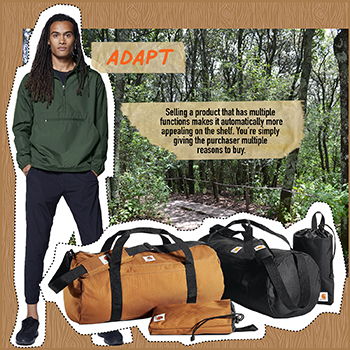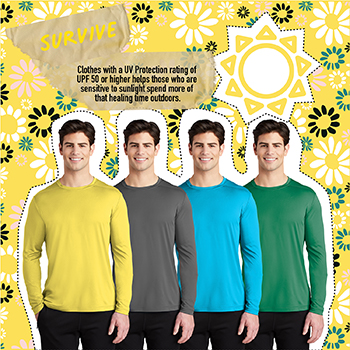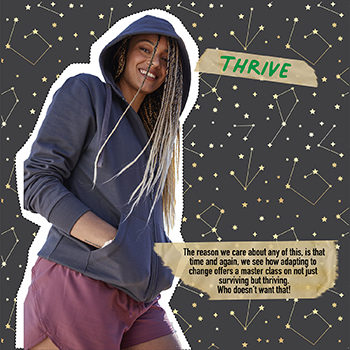We often see nature as a wholesome and healing place. Somewhere we can seek refuge from the modern world and get away from it all. And that is true, but the natural world can also be harsh and brutal too. It’s a place where survival of the fittest reigns supreme, though I’d argue that the same principles apply in our man-made worlds as well.
 The popular thought is that this refers to the biggest and strongest members of a species being the most successful, but what we’re really talking about is adaptability. Those who adapt, survive.
The popular thought is that this refers to the biggest and strongest members of a species being the most successful, but what we’re really talking about is adaptability. Those who adapt, survive.
This doesn’t just apply to wild animals. It works for us humans too, and the clothes we choose to wear have an increasingly important part to play. Inclusive and adaptive design is a trend we’ve seen develop for several years now. We see its influence in apparel that is more easily worn by a greater set of people as well as pieces that are adaptable to different uses and situations. REI, as one example, has been putting specific effort into their “For All” initiative, which (among other goals) works to “close the outdoor gap for the nearly 70% of American women who wear a size 14 or larger.”
In other words, inclusive design seeks to meet people where they are and develop apparel that fits them, their situation and their goals.
 This isn’t just about bringing in more people because it’s the right thing to do (which it is) – it makes good business sense too. If you design something that works for everyone, it can be used more easily and by more people. Selling a product that has multiple functions makes it automatically more appealing on the shelf. You’re simply giving the purchaser multiple reasons to buy.
This isn’t just about bringing in more people because it’s the right thing to do (which it is) – it makes good business sense too. If you design something that works for everyone, it can be used more easily and by more people. Selling a product that has multiple functions makes it automatically more appealing on the shelf. You’re simply giving the purchaser multiple reasons to buy.
You don’t have to look far to find specific examples of this. Jackets and vests that are packable from The North Face, Eddie Bauer, Sport-Tek and Port Authority let you adapt to the weather by wearing outerwear when you need it and stowing it away when you don’t. Carhartt and Port Authority’s collapsible, packable totes and duffel bags serve a similar function – they’re there when you need to carry something and easy to put away when the carrying is done. Clothes with a UV Protection rating of UPF 50 or higher help those who are sensitive to sunlight spend more time outdoors.
Adaptation doesn’t just happen in the specific features of the clothes we wear. It also shows up in overall industry trends and directions for years to come. Sporting goods and sports apparel had a surprisingly successful 2020, but they also learned from what changed and are already evolving to adapt to it, embracing athleisure as the new default and seeking to address new activity gaps that have developed.
 Even how we spend time with nature itself is in a state of flux, blending with technology in surprising ways. Portable tech allows us to bring our gadgets with us on outdoor adventures, offering more information at our fingertips or even an augmented reality experience. Meanwhile, technology is creating natural experiences that might be otherwise impossible, from birdwatching like it’s 1899 to sharing your own personal island paradise with the world. And yes, of course virtual apparel is a thing too!
Even how we spend time with nature itself is in a state of flux, blending with technology in surprising ways. Portable tech allows us to bring our gadgets with us on outdoor adventures, offering more information at our fingertips or even an augmented reality experience. Meanwhile, technology is creating natural experiences that might be otherwise impossible, from birdwatching like it’s 1899 to sharing your own personal island paradise with the world. And yes, of course virtual apparel is a thing too!
Adaptation even appears in the colors we’ve been gravitating toward. The Pantone Color Institute called it late last year, naming not one but two colors to encompass the trends of 2021 – the bright yellow Illuminating and the rock-solid Ultimate Grey. Here we see ourselves adapting through the colors we choose, grounded in stability while allowing ourselves to be optimistic, hopeful, and even playful! Seemingly polar opposites, our color adaptation brings together the conflicting ideas of where we are now: organic, natural colors that connect to the countryside and hypernatural brights that are equal parts nostalgic and mood boosting.
The reason we care about any of this is that time and again, we see how adapting to change offers a master class on not just surviving but thriving. Who doesn’t want that! Adaptable, inclusive apparel is a natural extension of our own need to roll with the changes and reach a wider audience. We’ve all been through a lot of change this last year — the way through it is to learn, adapt, and be ready to thrive.
Next month we’ll be taking a look at how people on the front lines of the pandemic have had to adapt, and how uniforms have changed along with them. See you then!
